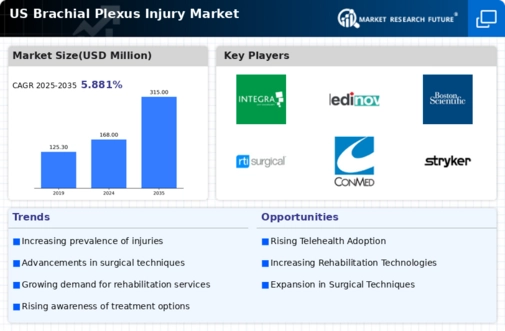The US Brachial Plexus Injury Market is characterized by a diverse array of players competing for market share through innovative product offerings and strategic partnerships. It is a niche segment within the broader healthcare landscape, focused on addressing the needs of patients with brachial plexus injuries, which can result from traumatic events such as accidents and childbirth complications. The competitive dynamics are shaped by factors such as technological advancement, regulatory landscape, and the rising demand for effective treatment options.
Companies in this market focus on developing surgical interventions, rehabilitation products, and emerging therapeutic techniques, enhancing their pipeline through ongoing research and development. As healthcare providers and patients increasingly seek effective solutions, companies strive to differentiate their offerings and establish a strong foothold.
Integra LifeSciences has established a significant presence within the US Brachial Plexus Injury Market, demonstrating strength through its innovative product portfolio and commitment to research and development. The company specializes in regenerative medicine and provides a range of solutions tailored to the needs of this specific patient demographic, including biological implants and surgical reconstruction products. Its dedication to advancing surgical techniques for nerve repair and regeneration has positioned Integra LifeSciences as a key player in this space.
The company's emphasis on tailored solutions and the robustness of its R&D efforts contribute to its competitive edge, enabling it to respond effectively to evolving market demands and enhancing patient outcomes.
Smith and Nephew also plays a noteworthy role in the US Brachial Plexus Injury Market, offering a broad spectrum of surgical and wound management solutions. The company is known for its advanced products catering to the complexities of brachial plexus injuries, including innovative surgical instruments and biologic materials that aim to enhance recovery and functionality for patients.
Smith and Nephew's strong market presence is bolstered by its successful mergers and acquisitions, which have expanded its product line and strengthened its position in this specific market. The company's ability to integrate new technologies and expand its reach through strategic operations provides a distinct advantage in delivering value to healthcare providers and improving patient experiences. Through continuous investment in innovative solutions and a comprehensive understanding of the market landscape, Smith and Nephew solidifies its status as a competitive force in addressing the complexities of brachial plexus injuries in the US.




















